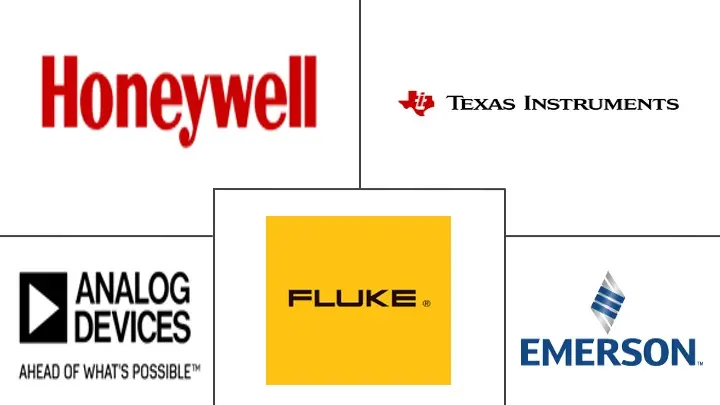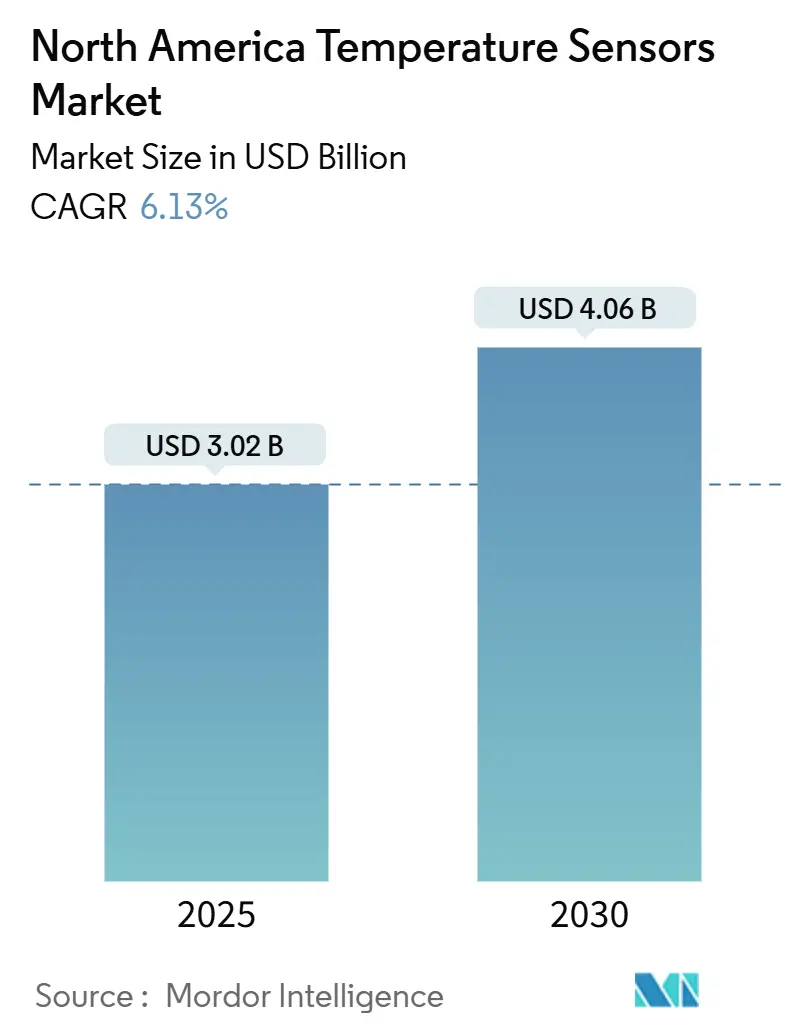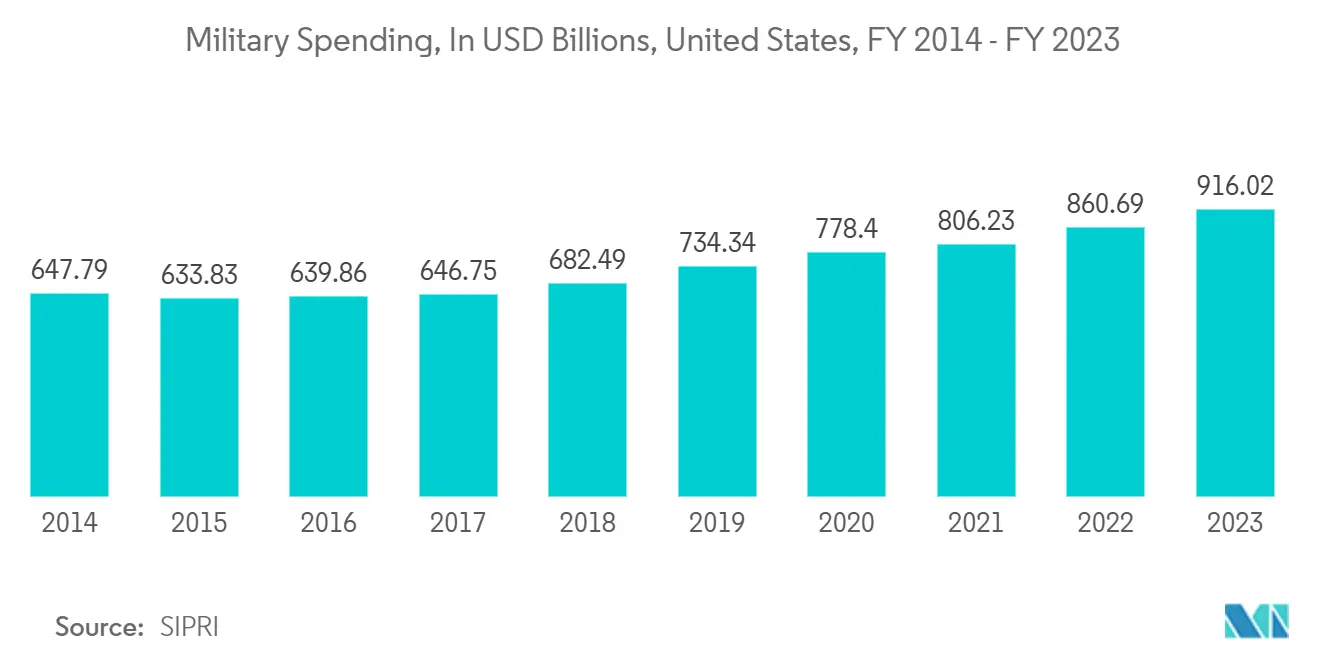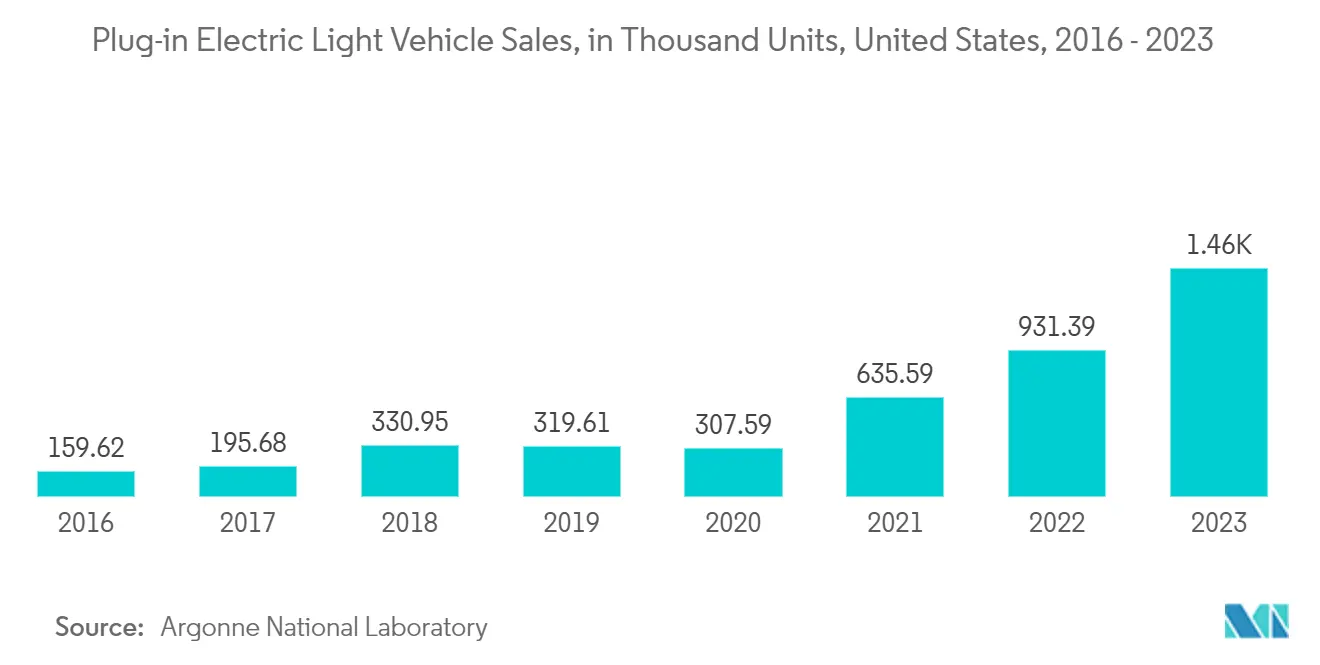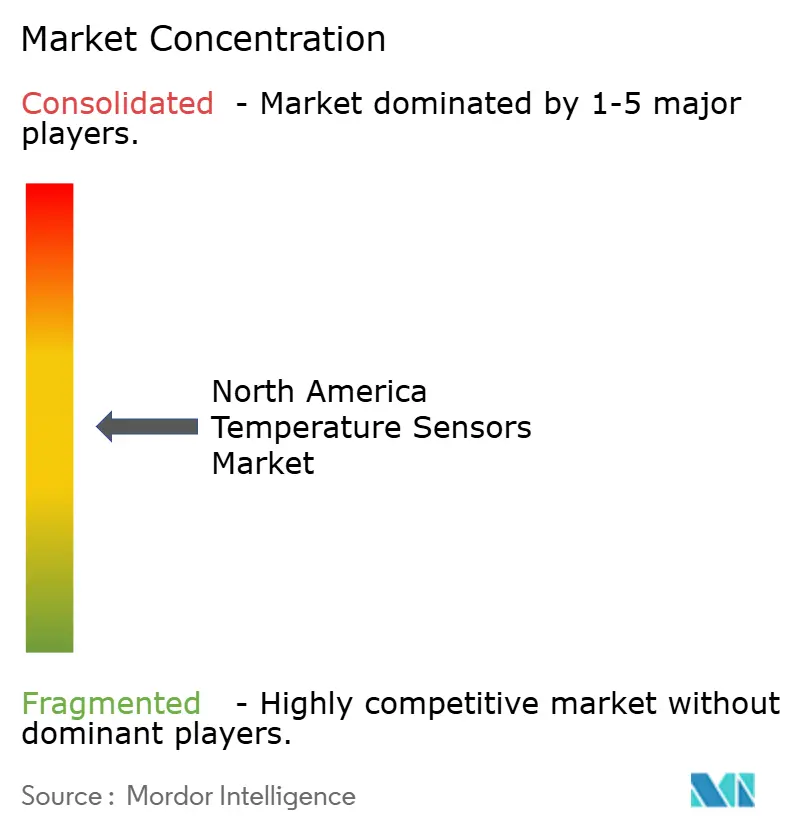North America Temperature Sensors Market Analysis
The North America Temperature Sensors Market size is estimated at USD 3.02 billion in 2025, and is expected to reach USD 4.06 billion by 2030, at a CAGR of 6.13% during the forecast period (2025-2030).
- The North America temperature sensors market is poised for substantial growth, with projected revenues and trends reflecting the increasing demand across various sectors. Industries such as aerospace, oil and gas, and mining, among others, are characterized by the harsh and complex operating environment and the adoption of a suitable sensor to withstand such external environment extremities and perform at the desired accuracy, reliability, precision, and repeatability are of crucial importance for these end-users.
- Rapid technological advancements in temperature monitoring have played a crucial role in the growth of wireless temperature sensors in the past few years. Multiple large-scale manufacturers have been focusing on implementing advanced concepts such as IR sensors and heat sensors. The usage of advanced concepts is further expected to open up significant potential for the market's growth in the coming years.
- With the increase in defense expenditure, wireless-type sensors have been an emerging technology area with multiple applications within the defense industry. Applications such as integrated vehicle health monitoring (IVHM) of defense and aerospace vehicles are primarily needed to ensure the crew's safety and the vehicle.
- At their essence, the sensor networks have been monitoring the physical characteristics of an environment and then translating those physical measurements to electrical impulses. The sensor networks primarily measure characteristics such as temperature, among others. In various cases, the network has been designed to sense the environment and act on the physical environment based on the sensed data.
- Further, fluctuations in the economy can impact capital expenditure in industries that rely heavily on temperature sensors, such as manufacturing and energy sectors. Economic downturns may lead to reduced investment in new technologies.
- The COVID-19 pandemic catalyzed the integration of temperature sensors into public health measures, leading to a surge in the use of body surface temperature sensors for screening purposes. This shift was driven by the need for effective monitoring tools to manage health risks associated with the virus. Additionally, post-pandemic, there was a marked increase in demand for non-contact temperature sensors, which were implemented as part of strict government regulations aimed at enhancing safety protocols.
North America Temperature Sensors Market Trends
Infrared Temperature Sensors to Drive the Market Growth
- IR temperature sensor applications are found in various defense applications, such as optical target sighting and variable emissivity measurements, that are often helpful in tracking activities. However, all these applications are very advanced and have a continuous demand due to the increasing military spending.
- In recent years, even the top snack manufacturers like Frito-Lay North America, Inc, a popular division of Pepsi Co, have started a new range of products, baked than fried. Such trends and stringent food safety regulations worldwide are expected to soon create substantial market opportunities for IR temperature sensors.
- Forward-Looking Infrared (FLIR) has been a prominent vendor for such technology. FLIR technology has been used in ports, borders, airports, and other places to look for elevated body temperatures. The company has significantly increased those orders in the past few years.
- The list of countries using FLIR products for temperature screening continues to grow. It now includes China, Thailand, Taiwan, the Philippines, Singapore, Malaysia, South Korea, Italy, and the U.S. The company stated that its supply chain is continuing to keep up with demand.
- Predictive maintenance is one of the functional uses of Infrared (IR) temperature sensors in the market; enterprises are increasingly focusing on predictive maintenance, automation, and IoT.
- Recently, Excelitas Technologies announced its latest CaliPile innovation, the high precision, medical grade TPiS 1T1386 L5.5H Thermopile sensor for remote skin-temperature measurement applications. Additionally, the CaliPile TPiS 1T1386 L5.5H’s smart data processing allows the sensor to signalize fast temperature changes or over-temperature via in-interrupt output aside from the precision temperature measurement.
United States Holds Significant Market Share
- The United States holds a significant market share due to advancements across various industries. With the R&D of multiple types of temperature sensors being integrated into different products, the market for temperature sensors is set to grow at a healthy rate.
- For instance, automakers such as General Motors plan to launch 20 new electric vehicles by 2023. The Tesla Company also changed the face of the EV market segment in the country by introducing reliable and efficient electric vehicles.
- The United States's automotive industry, directly and indirectly, employs hundreds of thousands of Americans and invests billions of dollars. It was estimated that the automotive industry yearly spends around USD 105 billion on R&D worldwide, USD 18 billion of which is spent in the US to incorporate newer and more advanced sensors into automobiles.
- With the US Department of the Interior planning to allow offshore exploratory drilling in about 90% of the Outer Continental Shelf acreage under the National Outer Continental Shelf Oil and Gas Leasing Program (National OCS Program) for 2019-2024, the oil and gas sector in the region is expected to open up new opportunities to the market.
- During the COVID-19 pandemic, the market witnessed increased demand for temperature sensors at the workplace for temperature screening. For instance, the Centers for Disease Control and Prevention in the United States and WHO (World Health Organization) recommended temperature checking at the workplace.
North America Temperature Sensors Industry Overview
The North America temperature sensor market is moderately fragmented due to many players operating in the market, such as Honeywell, Analog Devices Inc, and Texas Instruments, among other regional and local manufacturers. Continuous product up-gradation and industry convergence are driving the market towards highly differentiated offerings. Further, players adopt strategic initiatives such as mergers and acquisitions, partnerships, etc., to strengthen their market presence.
In summary, the North American temperature sensor market is poised for substantial growth, driven by technological advancements and increased applications across key industries. As the demand for smart solutions rises, manufacturers are likely to focus on innovation and integration with emerging technologies.
North America Temperature Sensors Market Leaders
-
Texas Instruments Incorporated
-
Honeywell International Inc
-
Analog Devices Inc
-
Fluke Process Instruments
-
Emerson Electric Company
- *Disclaimer: Major Players sorted in no particular order
North America Temperature Sensors Market News
- December 2024: Azilen Technologies, a leading US-based product engineering company, has announced advanced thermal sensing by integrating the ThingsBoard platform with advanced IoT-powered thermal monitoring devices. This innovative solution engineered from scratch for clients sets a new benchmark for precision and real-time temperature monitoring, catering specifically to temperature-sensitive industries such as AgriTech, healthcare, and logistics.
- November 2024: At CES 2025, Asahi Kasei MicrodevicesOpen new window (AKM), part of Asahi Kasei Corporation announced to unveil a suite of sensor technologies, including millimeter-wave (mmWave) radar and contactless monitoring. These technologies can make AgeTech more reliable and accessible while minimizing intrusion into users’ lives.
North America Temperature Sensors Industry Segmentation
The temperature sensors are devices to measure temperature readings through electrical signals. The sensor is made of two metals that generate electrical voltage or resistance once it notices a temperature change.
North America Temperature Sensor Industry is segmented by type (wired, wireless), technology (infrared, thermocouple, resistance temperature detectors (RTD), thermistor, temperature transmitters, fiber optic), end-user industry (chemical & petrochemical, oil & gas, metal & mining, power generation, food & beverage, automotive, medical, aerospace & military, consumer electronics), and country (United States, Canada). The market sizes and forecasts are provided in terms of value (USD) for all the above segments.
| By Type | Wired |
| Wireless | |
| By Technology | Infrared |
| Thermocouple | |
| Resistance Temperature Detector | |
| Thermistor | |
| Temperature Transmitter | |
| Fiber Optic | |
| Others | |
| By End-user Industry | Chemical & Petrochemical |
| Oil and Gas | |
| Metal and Mining | |
| Power Generation | |
| Food and Beverage | |
| Automotive | |
| Medical | |
| Aerospace and Military | |
| Consumer Electronics | |
| Other End-user Industries | |
| By Country | United States |
| Canada |
| Wired |
| Wireless |
| Infrared |
| Thermocouple |
| Resistance Temperature Detector |
| Thermistor |
| Temperature Transmitter |
| Fiber Optic |
| Others |
| Chemical & Petrochemical |
| Oil and Gas |
| Metal and Mining |
| Power Generation |
| Food and Beverage |
| Automotive |
| Medical |
| Aerospace and Military |
| Consumer Electronics |
| Other End-user Industries |
| United States |
| Canada |
North America Temperature Sensors Market Research FAQs
How big is the North America Temperature Sensors Market?
The North America Temperature Sensors Market size is expected to reach USD 3.02 billion in 2025 and grow at a CAGR of 6.13% to reach USD 4.06 billion by 2030.
What is the current North America Temperature Sensors Market size?
In 2025, the North America Temperature Sensors Market size is expected to reach USD 3.02 billion.
Who are the key players in North America Temperature Sensors Market?
Texas Instruments Incorporated, Honeywell International Inc, Analog Devices Inc, Fluke Process Instruments and Emerson Electric Company are the major companies operating in the North America Temperature Sensors Market.
What years does this North America Temperature Sensors Market cover, and what was the market size in 2024?
In 2024, the North America Temperature Sensors Market size was estimated at USD 2.83 billion. The report covers the North America Temperature Sensors Market historical market size for years: 2019, 2020, 2021, 2022, 2023 and 2024. The report also forecasts the North America Temperature Sensors Market size for years: 2025, 2026, 2027, 2028, 2029 and 2030.
Page last updated on: January 31, 2025
North America Temperature Sensors Industry Report
Statistics for the 2025 North America Temperature Sensors market share, size and revenue growth rate, created by Mordor Intelligence™ Industry Reports. North America Temperature Sensors analysis includes a market forecast outlook for 2025 to 2030 and historical overview. Get a sample of this industry analysis as a free report PDF download.

